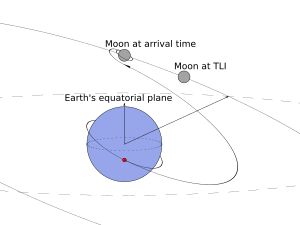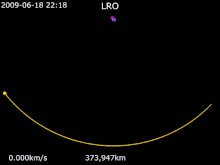用戶:DrizzleD/地月轉移軌道
| 此用戶頁目前正依照en:Wikipedia上的內容進行翻譯。 (2020年5月8日) |

月球轉移軌道(Lunar Transfer Orbit, LTO,亦稱為地月轉移軌道)是探測器從環繞地球運行轉變為環繞月球運行所經歷的軌道,常常是類霍曼轉移軌道。
月球轉移入軌(Trans-Lunar Injection, TLI)是一種經由月球轉移軌道到達月球的軌道機動。
歷史[編輯]

GRAIL-A · Moon · Earth

Earth · Moon · Chandrayaan-2

== 歡迎加入維基百科! == 您好,DrizzleD!
感謝您對維基百科的興趣與貢獻,希望您會喜歡這裏,也請您了解以下重要文章: * 五大支柱:了解維基百科的基石。 * 可供查證:撰寫條目時,請保證有據可查。 * 版權問題解答:維基百科非常重視版權,請勿隨意複製貼上。 * 新手入門教程、如何編輯頁面、建立條目精靈:帶您逐步熟悉維基百科。 有疑問?需要幫助?歡迎到互助客棧或IRC頻道詢問。
祝您編輯愉快!
第一次月球轉移入軌的嘗試是由蘇聯的月球一號做出的。這枚探測器於1959年1月2日發射,計劃在月球上硬着陸。然而,其入軌精度未達預期,最終以超過三倍月球半徑的距離錯過月球。[1]月球二號於同年9月2日執行了同樣的機動,並改進了入軌精度,於兩天後成功撞擊月球。[2]蘇聯人之後在1959至1976年間又成功執行了22項月球計劃任務和5項探測器計劃任務。[3]
美國於1962年1月26日啟動其首次月球硬着陸嘗試徘徊者3號,但同樣未能成功達成目標。隨後,美國於同年4月23日成功發射了徘徊者4號。[4] Another 27 missions to the Moon were launched from 1962 to 1973, including five successful Surveyor soft landers, five Lunar Orbiter surveillance probes,[5]:166 and nine Apollo missions, which landed the first humans on the Moon. 1968年發射的阿波羅8號是人類首次載人月球轉移入軌任務。[6]
For the Apollo lunar missions, TLI was performed by the restartable J-2 engine in the S-IVB third stage of the Saturn V rocket. This particular TLI burn lasted approximately 350 seconds, providing 3.05 to 3.25 km/s (10,000 to 10,600 ft/s) of change in velocity (delta-v), at which point the spacecraft was traveling at approximately 10.4 km/s (34150 ft/s) relative to the Earth.[7] The Apollo 8 TLI was spectacularly observed from the Hawaiian Islands in the pre-dawn sky south of Waikiki, photographed and reported in the papers the next day.[8] In 1969, the Apollo 10 pre-dawn TLI was visible from Cloncurry, Australia.[9] It was described as resembling car headlights coming over a hill in fog, with the spacecraft appearing as a bright comet with a greenish tinge.[9]
In 1990 Japan launched its first lunar mission, using the Hiten satellite to fly by the Moon and place the Hagoromo microsatellite in a lunar orbit. Following that, it explored a novel low delta-v TLI method with a 6-month transfer time (compared to 3 days for Apollo).[10][5]:179
The 1994 US Clementine spacecraft, designed to showcase lightweight technologies, used a 3 week long TLI with two intermediate earth flybys before entering a lunar orbit.[10][5]:185
In 1997 Asiasat-3 became the first commercial satellite to reach the Moon's sphere of influence when, after a launch failure, it swung by the Moon twice as a low delta-v way to reach its desired geostationary orbit. It passed within 6200 km of the Moon's surface.[10][5]:203
The 2003 ESA SMART-1 technology demonstrator satellite became the first European satellite to orbit the Moon. After being launched into a geostationary transfer orbit (GTO), it used solar powered ion engines for propulsion. As a result of its extremely low delta-v TLI maneuver, the spacecraft took over 13 months to reach a lunar orbit and 17 months to reach its desired orbit.[5]:229
China launched its first Moon mission in 2007, placing the Chang'e 1 spacecraft in a lunar orbit. It used multiple burns to slowly raise its apogee to reach the vicinity of the Moon.[5]:257
India followed in 2008, launching the Chandrayaan-1 into a GTO and, like the Chinese spacecraft, increasing its apogee over a number of burns.[5]:259
The soft lander Beresheet from the Israel Aerospace Industries, used this maneuver in 2019, but crashed on the Moon.
In 2011 the NASA GRAIL satellites used a low delta-v route to the Moon, passing by the Sun-Earth L1 point, and taking over 3 months.[5]:278
理論[編輯]
典型的地月轉移入軌和霍曼轉移相仿,不過低能量轉移有時也被使用,飛天號探測器就是。[11]對於沒有顯着地月系外攝動的短期任務,快霍曼轉移往往更實際。
A spacecraft performs TLI to begin a lunar transfer from a low circular parking orbit around Earth. The large TLI burn, usually performed by a chemical rocket engine, increases the spacecraft's velocity, changing its orbit from a circular low Earth orbit to a highly eccentric orbit. As the spacecraft begins coasting on the lunar transfer arc, its trajectory approximates an elliptical orbit about the Earth with an apogee near to the radius of the Moon's orbit. The TLI burn is sized and timed to precisely target the Moon as it revolves around the Earth. The burn is timed so that the spacecraft nears apogee as the Moon approaches. Finally, the spacecraft enters the Moon's sphere of influence, making a hyperbolic lunar swingby.
Free return[編輯]

In some cases it is possible to design a TLI to target a free return trajectory, so that the spacecraft will loop around behind the Moon and return to Earth without need for further propulsive maneuvers.[12]
Such free return trajectories add a margin of safety to human spaceflight missions, since the spacecraft will return to Earth "for free" after the initial TLI burn. The Apollos 8, 10 and 11 began on a free return trajectory,[13] while the later missions used a functionally similar hybrid trajectory, in which a midway course correction is required to reach the moon.[14][15][16]
Modeling[編輯]

Patched conics[編輯]
TLI targeting and lunar transfers are a specific application of the n body problem, which may be approximated in various ways. The simplest way to explore lunar transfer trajectories is by the method of patched conics. The spacecraft is assumed to accelerate only under classical 2 body dynamics, being dominated by the Earth until it reaches the Moon's sphere of influence. Motion in a patched-conic system is deterministic and simple to calculate, lending itself for rough mission design and "back of the envelope" studies.
Restricted circular three body (RC3B)[編輯]
More realistically, however, the spacecraft is subject to gravitational forces from many bodies. Gravitation from Earth and Moon dominate the spacecraft's acceleration, and since the spacecraft's own mass is negligible in comparison, the spacecraft's trajectory may be better approximated as a restricted three-body problem. This model is a closer approximation but lacks an analytic solution,[17] requiring numerical calculation.[18]
Further accuracy[編輯]
More detailed simulation involves modeling the Moon's true orbital motion; gravitation from other astronomical bodies; the non-uniformity of the Earth's and Moon's gravity; including solar radiation pressure; and so on. Propagating spacecraft motion in such a model is numerically intensive, but necessary for true mission accuracy.
參見[編輯]
參考文獻[編輯]
- ^ Luna 01. NASA.
- ^ NASA - NSSDCA - Spacecraft - Details. nssdc.gsfc.nasa.gov.
- ^ Soviet Missions to the Moon. nssdc.gsfc.nasa.gov.
- ^ Ranger 4. NASA.
- ^ 5.0 5.1 5.2 5.3 5.4 5.5 5.6 5.7 Beyond Earth (PDF). NASA.
- ^ Mars, Kelli. 50 Years Ago: Apollo 8, You are Go for TLI!. NASA. December 20, 2018.
- ^ Apollo By the Numbers. NASA. (原始內容存檔於2004-11-18).
- ^ Independent Star News, Sunday, December 22, 1968. "The TLI firing was begun at PST while the craft was over Hawaii and it was reported there that the burn was visible from the ground."
- ^ 9.0 9.1 French, Francis; Colin Burgess. In the Shadow of the Moon. University of Nebraska Press. 2007: 372. ISBN 978-0-8032-1128-5.
- ^ 10.0 10.1 10.2 Alexander M. Jablonski1a; Kelly A. Ogden. A Review of Technical Requirements for Lunar Structures – Present Status (PDF). International Lunar Conference 2005. 2005.
- ^ Hiten. NASA.
- ^ Schwaninger, Arthur J. Trajectories in the Earth-Moon Space with Symmetrical Free Return Properties (PDF). Technical Note D-1833. Huntsville, Alabama: NASA / Marshall Space Flight Center. 1963.
- ^ Mansfield, Cheryl L. Apollo 10. NASA. May 18, 2017.
- ^ APOLLO 12. history.nasa.gov.
- ^ Ways to the Moon (PDF) (報告): 93.
- ^ Launch Windows Essay. history.nasa.gov.
- ^ Henri Poincaré, Les Méthodes Nouvelles de Mécanique Céleste, Paris, Gauthier-Villars et fils, 1892-99.
- ^ Victor Szebehely, Theory of Orbits, The Restricted Problem of Three Bodies, Yale University, Academic Press, 1967.
